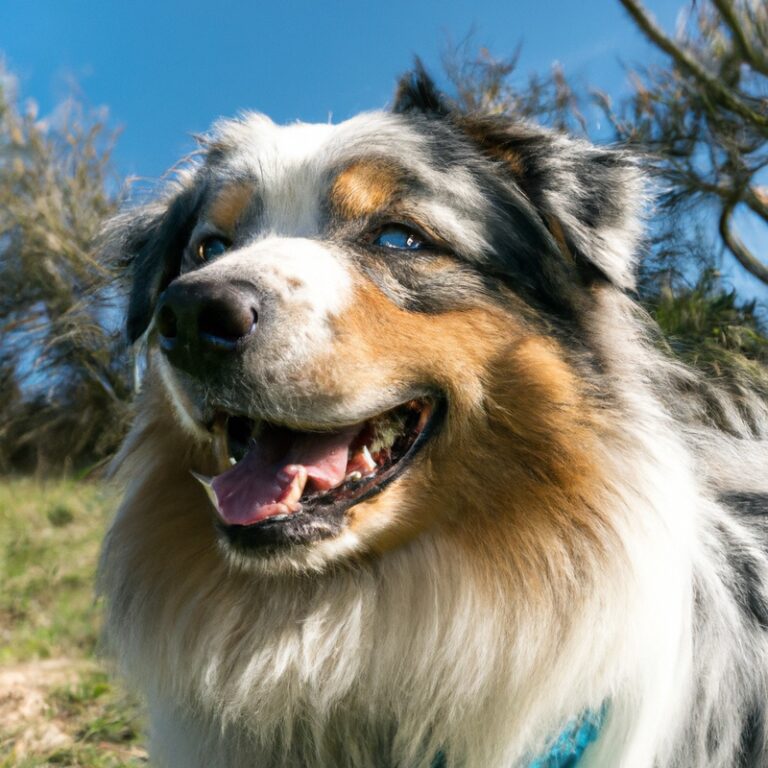How Do Australian Shepherds Handle Being Home Alone?
Key Takeaways:
- Australian Shepherds can handle being home alone if they are properly trained and exercised.
- Providing mental stimulation through interactive toys and puzzles can help Australian Shepherds cope with being alone.
- Separation anxiety can be a challenge for Australian Shepherds, but it can be managed through gradual desensitization techniques.
- Regular communication and socialization with other dogs can contribute to a better home-alone experience for Australian Shepherds.
Are you a proud Australian Shepherd owner? Then you know that these energetic and intelligent pups need plenty of attention and activities to keep their minds and bodies busy.
But what happens when you have to leave them home alone?
As an expert in the field, I can assure you that there are effective strategies to help your Australian Shepherd handle solitude with grace and ease. From socialization and mental stimulation to creating a safe environment and establishing a consistent routine, this article will provide you with all the tips and tricks you need to ensure your furry friend feels comfortable and secure when you’re away.
So, let’s dive in and explore the world of Australian Shepherds and how they handle being home alone!
| Pros | Cons | |
| Independence | Can handle being alone for moderate periods of time | May become anxious or bored if left alone for long periods |
| Energy Level | With sufficient exercise, can be calm when left alone | May become hyperactive or destructive if not properly exercised |
| Training | Easy to train and can be taught to be comfortable alone | May exhibit separation anxiety if not properly trained |
| Company | Can be content with own company if provided with mental stimulation | Tend to be social dogs and thrive with human or animal companionship |
Understanding Australian Shepherds’ needs
Socialization and exercise requirements
Socialization and exercise are crucial for Australian Shepherds’ overall well-being. Regular exercise helps them expend energy and maintain a healthy weight.
They require vigorous exercise such as running, hiking, or playing fetch.
Mental stimulation is equally important and can be achieved through agility training or puzzle toys. Socialization is also vital as it helps them become well-rounded and confident dogs.
Expose them to different people, animals, and environments from a young age.
Encourage positive interactions and rewards for good behavior. Enroll them in puppy classes or socialization groups to ensure they learn appropriate social skills.
Be mindful of their exercise needs and provide outlets for mental stimulation to prevent boredom and destructive behavior.
Set aside dedicated time for training sessions and playtime to bond with your Australian Shepherd. By meeting their socialization and exercise requirements, you’ll help them lead a happy and balanced life.
Mental stimulation and enrichment activities
Mental stimulation and enrichment activities are essential for Australian Shepherds, especially when they are home alone. These intelligent and active dogs need mental stimulation to prevent boredom and destructive behavior.
Here are some ideas to keep your Australian Shepherd mentally engaged while you’re away:
- Puzzle toys: Provide interactive toys that require problem-solving skills to access treats or toys hidden inside. This engages their mind and keeps them entertained.
- Training games: Teach your Australian Shepherd new commands or tricks. This not only stimulates their brain but also strengthens the bond between you and your furry friend.
- Nosework: Hide treats or toys around the house for your dog to find. This taps into their natural scenting abilities and provides a mentally stimulating activity.
- Treat-dispensing toys: Use toys that dispense treats as your dog plays with them. This keeps them occupied and encourages them to work for their rewards.
- Rotate toys: Switch out toys regularly to keep them interesting and prevent boredom. This way, your Australian Shepherd won’t get tired of playing with the same toys every day.
- Interactive games: Play hide-and-seek or chase games with your dog, either before you leave or when you come back. This provides mental stimulation and helps burn off energy.
By providing mental stimulation and enrichment activities, you can help prevent boredom and ensure that your Australian Shepherd remains happy and content when you’re not around. Remember, a tired and satisfied dog is less likely to engage in destructive behaviors.

Importance of a consistent routine

Preparing your home for a lone Australian Shepherd
Creating a safe and comfortable environment
Creating a safe and comfortable environment for your Australian Shepherd is essential when they are home alone. Here are some key tips to help you achieve this:
- Provide a designated space: Set up a specific area in your home where your Australian Shepherd can feel safe and secure. This can be a crate, a comfortable dog bed, or a gated-off section of the house.
- Remove hazards: Make sure to remove any potential dangers from your dog’s environment. This includes toxic plants, electrical cords, and small objects that they could swallow.
- Puppy-proof your home: If you have a young Australian Shepherd, take extra precautions to puppy-proof your home. Use baby gates to block off areas, secure cabinets, and keep household chemicals out of reach.
- Temperature control: Ensure that the temperature in your home is comfortable for your dog, especially if they are left alone for long periods. Consider using fans, air conditioning, or heating devices to maintain an optimal temperature.
- Provide access to water: Always have fresh water available for your Australian Shepherd. Consider using a spill-proof water bowl or providing multiple water stations throughout the house.
- Natural lighting: Natural light can help improve your dog’s mood and well-being. Leave curtains or blinds open to allow natural light to enter the room where your Australian Shepherd will spend their time.
By creating a safe and comfortable environment, you are setting the foundation for a positive and stress-free experience for your Australian Shepherd when they are home alone.

Providing appropriate toys and chews
When it comes to providing appropriate toys and chews for your Australian Shepherd, there are a few key things to keep in mind. Firstly, it’s important to choose toys that are durable and safe for your dog to play with.
This means avoiding small, easily swallowable parts that could pose a choking hazard.
Secondly, consider your dog’s individual preferences and playstyle. Some Australian Shepherds enjoy interactive toys that challenge their problem-solving skills, while others prefer toys they can chew on to relieve boredom.
By offering a variety of toys that cater to your dog’s needs, you can keep them engaged and entertained.
Thirdly, it’s crucial to rotate your dog’s toys regularly to prevent boredom. This can help keep their interest and prevent them from becoming destructive or disinterested in the toys they have.
By providing a fresh selection of toys and chews, you can keep your Australian Shepherd stimulated and prevent them from getting bored or anxious when left alone.
Addressing separation anxiety
Addressing separation anxiety in Australian Shepherds is essential for their well-being and your peace of mind. Separation anxiety can manifest in various ways, such as excessive barking, destructive behavior, or even self-harm.
Here are some effective strategies to help your Australian Shepherd cope with being alone:
- Gradual desensitization: Start by leaving your dog alone for short periods and gradually increase the duration. This helps them build confidence and trust that you’ll return.
- Crate training: Many dogs find solace in having a den-like space. Introduce your Australian Shepherd to a crate and make it a positive and safe place for them.
- Positive reinforcement: Reward your dog for calm behavior before and after being alone. This helps them associate positive experiences with being by themselves.
- Enrichment toys: Provide interactive toys, puzzle games, or treat-dispensing toys to keep your Australian Shepherd mentally stimulated and occupied while you’re away.
- Calming aids: Consider using products like pheromone diffusers, calming sprays, or relaxing music to create a soothing environment for your dog.
- Seek professional help: If your Australian Shepherd’s separation anxiety is severe, consult a professional dog trainer or a veterinary behaviorist for guidance and specialized assistance.
Remember, each dog is unique, and it may take time to find what works best for your Australian Shepherd. Patience, consistency, and empathy are the keys to addressing separation anxiety successfully.
Training and conditioning for solitude
Gradual desensitization to being alone
One effective approach to help Australian Shepherds adjust to being alone is through gradual desensitization. This means slowly increasing the amount of time they spend alone, starting from just a few minutes and gradually building up to longer periods.
To begin, start by leaving your Australian Shepherd alone for short intervals while providing them with a safe and comfortable space.
Gradually increase the duration over time, always monitoring their response. It’s important to ensure that each session ends on a positive note, so your dog doesn’t associate being alone with negative experiences.
During the desensitization process, it can be helpful to engage your dog in independent activities and provide mental stimulation.
Interactive toys, puzzle feeders, and treat-dispensing toys can keep them occupied and help them associate being alone with positive experiences. Positive reinforcement is key throughout the process.
Reward your Australian Shepherd with treats, praise, and affection when they exhibit calm behavior while alone.
This helps them associate being alone with positive reinforcement and builds their confidence in being independent. Remember, consistency and patience are key when desensitizing your Australian Shepherd to being alone.
Rushing the process or leaving them for extended periods too soon can lead to anxiety or negative associations.
Gradual desensitization, along with a few other strategies, can help your Australian Shepherd handle being home alone without distress. Now, let’s move on to the next section and discuss crate training and confinement options.
Crate training and confinement options
Crate training can be an effective way to help Australian Shepherds handle being home alone. By providing them with their own safe space, it can help minimize anxiety and prevent destructive behaviors.
When crate training, it’s important to introduce the crate gradually and make it a positive experience.
Start by leaving the crate door open and placing treats or toys inside to encourage your dog to enter. Once your dog is comfortable going in and out of the crate, you can start closing the door for short periods of time, gradually increasing the duration.
It’s also important to ensure that the crate is the appropriate size for your Australian Shepherd.
It should be big enough for them to stand up, turn around, and lie down comfortably, but not too big that they have excessive space. This helps create a den-like environment that provides a sense of security for your dog.
In addition to crate training, there are other confinement options available.
Playpens or exercise pens can be used to create a larger confined area where your Australian Shepherd can move around more freely. These pens can be set up in a designated area of your home and can be equipped with toys, water, and bedding.
Another option is to use baby gates to restrict your dog’s access to certain areas of the house.
This allows them to have more space to move around while still being contained within a safe area. Remember, crate training and confinement options should be used in conjunction with other strategies such as exercise, mental stimulation, and a consistent routine to help your Australian Shepherd handle being home alone.
It’s important to observe your dog’s behavior and seek professional help if they show signs of distress or anxiety.
Positive reinforcement for good behavior
Positive reinforcement is a highly effective way to encourage good behavior in Australian Shepherds. This training method involves rewarding your dog with praise, treats, or playtime when they exhibit the desired behavior.
By consistently rewarding your Australian Shepherd for being calm, quiet, or engaging in appropriate activities while home alone, you can reinforce these positive behaviors.
This helps them associate being alone with positive experiences and reduces any anxiety or stress they might feel. Consistency and patience are key when using positive reinforcement, so make sure to reward good behavior every time it occurs.
Strategies for leaving an Australian Shepherd alone
Establishing a departure routine
Establishing a departure routine is essential for Australian Shepherds when it comes to being home alone. It helps them feel more secure and reduces anxiety.
Here are a few tips to help you establish a departure routine:
- Be consistent: Establish a consistent routine by leaving and returning at the same time each day. This helps your dog understand when to expect your departure and arrival.
- Gradual desensitization: Start by leaving your Australian Shepherd alone for short periods and gradually increase the duration. This helps them get used to being alone and builds their confidence.
- Prepare for departure: Before leaving, engage in activities that will tire your dog out mentally and physically. This can include a walk, playtime, or puzzle toys. A tired dog is more likely to relax when you’re away.
- Stay calm and low-key: When it’s time to leave, avoid making a big fuss or saying goodbye. Keep your departure low-key to prevent your dog from associating your leaving with excitement or anxiety.
- Provide distractions: Leave interactive toys and puzzles for your Australian Shepherd to keep them entertained while you’re away. These can include Kong toys stuffed with treats or puzzle feeders.
- Consider leaving music or TV on: Some dogs find comfort in background noise. Leaving the radio or TV on at a low volume can help keep your dog relaxed and provide a sense of company.
Utilizing technology and enrichment devices
Utilizing technology and enrichment devices can be incredibly helpful in keeping your Australian Shepherd occupied and entertained while you’re away. Here are a few ways you can use technology and enrichment devices:
- Interactive toys: Invest in interactive toys that dispense treats or make sounds when played with. This can keep your Australian Shepherd stimulated and engaged.
- Puzzle toys: Puzzle toys are a great way to mentally challenge your dog. These toys require problem-solving skills to access treats or toys hidden inside. They can provide hours of entertainment and mental stimulation.
- Automatic feeders and water dispensers: These devices can ensure that your Australian Shepherd has access to food and water throughout the day. This can be especially helpful if you’re unable to be home during their regular feeding times.
- Dog cameras: Set up a dog camera in your home so you can check on your Australian Shepherd while you’re away. Some cameras even have interactive features, allowing you to speak to your dog or dispense treats remotely.
Overall, utilizing technology and enrichment devices can help keep your Australian Shepherd mentally and physically stimulated while they are home alone. It’s important to introduce these devices gradually and always monitor your dog’s behavior to ensure they’re enjoying and benefiting from them.
Engaging the help of professionals or dog sitters
Engaging the help of professionals or dog sitters can be a great solution for leaving your Australian Shepherd alone. They can provide the care and attention your dog needs while you are away.
Professional dog sitters are experienced in taking care of pets and can offer companionship, exercise, and mental stimulation.
They can follow your instructions and provide a routine that suits your dog’s needs. A dog sitter can also help alleviate any separation anxiety your Australian Shepherd may experience when left alone.
Additionally, having a professional come to your home can provide a sense of security for your dog, as they will be in a familiar environment.
This can reduce stress and help maintain a consistent routine. If you choose to utilize a dog daycare facility, make sure to research and choose a reputable one that is experienced in caring for Australian Shepherds.
This will ensure that your dog receives proper attention and socialization.
When selecting a dog sitter or daycare facility, consider their qualifications, reviews, and if they have experience with Australian Shepherds. Trust is essential when it comes to leaving your beloved pet in someone else’s care, so take the time to find someone who you feel comfortable with.
Overall, engaging the help of professionals or dog sitters can provide peace of mind knowing that your Australian Shepherd is well taken care of while you’re away.
Do thorough research, meet the individuals in person, and introduce your dog to them before making a final decision. This way, you can choose the best care option for your furry friend.
Recognizing signs of distress or boredom
Understanding body language and behavior cues
Understanding your Australian Shepherd’s body language and behavior cues is crucial for assessing their emotional state when left alone. Some signs of distress or boredom include excessive panting, pacing, drooling, or destructive behavior.
They may also display avoidance behaviors, such as hiding or attempting to escape.
On the other hand, a content and well-adjusted dog may exhibit relaxed body posture, calm breathing, and a willingness to engage in activities or play. By observing and interpreting these cues, you can better understand your Australian Shepherd’s needs and address any issues that arise.
Dealing with excessive barking or destructive behavior
Dealing with excessive barking or destructive behavior can be challenging, but there are strategies that can help. One important step is to identify the underlying cause of the behavior.
Is your Australian Shepherd bored, anxious, or seeking attention?
Once you understand the root cause, you can address it directly. To combat excessive barking, it’s crucial to provide mental and physical stimulation.
Make sure your dog is getting enough exercise and playtime.
Additionally, engage them in puzzle toys or interactive games that will keep their mind occupied. You can also try desensitizing them to triggers that may cause barking, such as doorbells or passing cars, by gradually exposing them to these stimuli in a controlled manner.
When it comes to destructive behavior, it’s essential to provide appropriate outlets for your dog’s energy.
Ensure they have plenty of chew toys and interactive games to keep them occupied. If necessary, confine them to a safe space, like a crate or a designated room, when you’re away.
This can prevent them from damaging your belongings.
Remember, positive reinforcement is key. Reward your Australian Shepherd for good behavior and ignore unwanted behaviors.
Consistency is also important, so establish clear boundaries and enforce them consistently.
Professional training or behavioral consultations can be beneficial if the issue persists. By addressing the underlying cause, providing mental and physical stimulation, and using positive reinforcement, you can help your Australian Shepherd overcome excessive barking or destructive behavior.
Patience and consistency are key, and with time, your dog can learn to be calm and content when left alone.
The role of regular exercise and mental stimulation
Regular exercise and mental stimulation play a crucial role in keeping Australian Shepherds happy and content when they are home alone. This breed is highly energetic and intelligent, so providing them with adequate physical activity and mental challenges is essential.
Exercise helps to tire out their bodies and release pent-up energy.
Going for long walks, playing fetch, or participating in agility training are great ways to keep them physically active. It also helps prevent behavioral issues that can arise from boredom or frustration.
Mental stimulation is equally important for Australian Shepherds.
They thrive on tasks that engage their minds and problem-solving abilities. Interactive toys, puzzle games, and obedience training sessions are excellent ways to challenge their intellect and provide mental stimulation.
By ensuring that your Australian Shepherd gets regular exercise and mental stimulation before leaving them home alone, you can help prevent them from becoming bored or restless.
This will contribute to their overall well-being and reduce the risk of destructive behavior or excessive barking. Remember, each dog is unique, so it’s essential to tailor the exercise and mental stimulation to your Australian Shepherd’s specific needs and preferences.
Additional considerations for specific age groups
Puppies and their unique requirements
Puppies have unique requirements when it comes to being home alone. As a puppy owner, it’s important to understand their needs and ensure they feel safe and comfortable while you’re away.
One important aspect is crate training.
Providing a crate can give your puppy a sense of security and help prevent accidents or destructive behavior. Gradual desensitization to being alone is also key.
Start by leaving your puppy alone for short periods of time and gradually increase the duration as they become more comfortable.
Another crucial aspect is providing mental stimulation and enrichment activities. Puppies have lots of energy and need outlets for their curiosity.
Interactive toys, puzzle feeders, and chew toys can keep them occupied and mentally engaged.
Establishing a consistent routine is also important for puppies. They thrive on predictability and knowing what to expect.
Be sure to provide regular exercise, playtime, feeding schedules, and potty breaks.
Since puppies have shorter attention spans and may be prone to separation anxiety, it’s important to address any signs of distress or boredom. Keeping them physically and mentally stimulated can help prevent destructive behavior or excessive barking.
Adult and senior Australian Shepherds
Adult and senior Australian Shepherds have specific needs when it comes to being home alone. As they mature, they may require less physical exercise but still need mental stimulation and social interaction.
It’s important to provide them with a comfortable and safe environment, including appropriate toys and chews to keep them entertained.
Gradual desensitization and positive reinforcement can help them adjust to being alone, and creating a consistent routine will provide them with a sense of security. It’s essential to recognize signs of distress or boredom, address separation anxiety if necessary, and ensure they get regular exercise and mental stimulation.
Final Verdict
It is essential to understand and cater to the specific needs of Australian Shepherds when it comes to being home alone. They require socialization, exercise, mental stimulation, and a consistent routine to thrive in solitude.
By preparing the home, providing appropriate toys, and addressing separation anxiety, we can create a safe and comfortable environment for our furry friends.
Training and conditioning techniques, such as gradual desensitization and positive reinforcement, can help them adjust to being alone. Utilizing departure routines, technology, and professional help can also make their time alone more manageable.
Being attentive to signs of distress or boredom, addressing excessive barking or destructive behavior, and ensuring regular exercise and mental stimulation are crucial.
Moreover, it is important to consider the unique requirements of puppies, adult, and senior Australian Shepherds. By implementing these strategies and understanding their needs, we can help our Australian Shepherds handle being home alone with greater ease and contentment.







